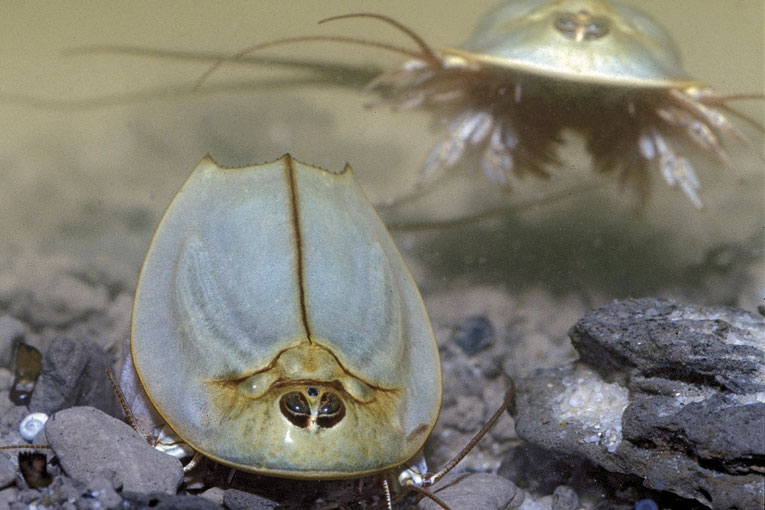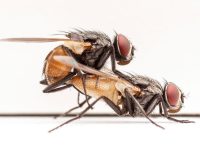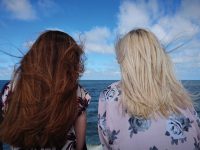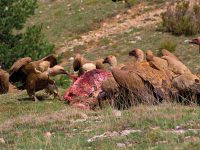
The curious and primitive aspect of Triops is certainly noteworthy. In fact, it has been under consideration by zoologists for a long time. If we compared fossils with currently living members of the species, we would not be able to tell the difference. These fossils are more than 250 million years old (Permian) and have undergone no noticeable modifications since then.
This morphology is considered similar to that of the «ancestral» arthropod, origin of the immense group of crustaceans. It is surprising to think that they were already swimming in superficial ponds before dinosaurs appeared and they also contemplated their extinction. This proves size is not always crucial and that those powerful dinosaurs were not «superior» to our protagonist, as it adapted to the dramatic changes our planet experienced to this day.
What and how are the Triops?
Triops are notostraca, the most primitive group of crustaceans (originated around 300 million years ago), and evolutionarily close to artemia and small water fleas. There are two known genera (Triops and Lepidurus); we will cover the first one here. In the Iberian Peninsula only one genus was considered local: Triops cacriformis. Although some authors have recently separated it into different species, we will use the term cancriformis to refer to all of them, as the differences between them will not affect our explanation.
«‘Triops’ were already swimming in superficial ponds before dinosaurs appeared and they also contemplated their extinction. This proves size is not always crucial»
The name of the genus (Triops) comes from its three eyes (tri: “three”; ops: “eyes”), two compound eyes and a larval ocellus, commonly unnoticed because it has decreased a lot in size. However, it still appears to have three clearly defined eyes because its nuchal organ looks like a third eye. The name of the species (cancriformis) comes from its resemblance to a crab (cancri: “crab”; formis: “form”), although for a lot of people it rather resembles a saucepan crab.

Ventral view of a Triops cancriformis that reminds us of a crab (cancri: crab, formis: form). / Albert Ruhí
The Catalan popular name, tortuguets or tortuguetes, comes from villages around Valencian rice fields. The term refers to the protective dorsal shield (in the shape of a turtle carapace), from which a «tail» comes out (the abdomen ends in a fork –the telson– to which two long appendages –the cerci– are attached). In some English-speaking countries it is known as tadpole shrimp. In some villages in Catalonia, people call them greixandos rars (greixando being the name they give to tadpoles in the area of El Pla de l’Estany, in North-East Catalonia, and rars meaning odd), because they usually live together with true frog and toad tadpoles in temporary ponds.
It is a fresh-water species up to seven centimetres long (plus the length of the caudal cerci). Eleven segments can be counted on the thorax, each one with its own pair of thoracic appendages, although the first two are heavily modified. The eleventh pair is in females a circular structure in which eggs are deposited. The swimming legs, to which gills are attached, renew the water, favouring breathing. When they are close to the bottom they swim normally (legs down), but when they swim close to the surface they usually do it belly-up, showing any observer the peculiar structure of their body.
Reproduction and Feeding

Dorsal view of a Triops showing the shield in the shape of a turtle shell. / Albert Masó
It is precisely the fact that they live in environments that remain dry for part of the year that roused the interest on the study of their reproductive biology. As many other crustacean species, during the pond’s dry stage eggs are the only way the species can survive the lack of water. Hatching and intervening factors have been object to a lot of experimental work. The main determinants are salinity, light and draining. Thus, salinity inhibits hatching, while light not only favours it, but is necessary. Other factors such as UV radiation don’t seem necessary for hatching, but they stimulate it. A great resistance of the eggs to both high and low temperatures has been accounted for (they survive to temperatures higher than 80 ºC and lower than –190 ºC), but if they are not completely dry the temperature range decreases considerably.

Triops live in a changing and ephemeral environment, where many species are not able to survive. Their adaptation to temporari ponds is based on a fast population development. On the left, “l’estanyol d’Espolla” of Fontcoberta and Porqueres (Pla de l’Estany). On the right, “es Mal Lloc” (Menorca). / Albert Masó, Albert Ruhí
The moment the desiccation happens is very important, because it affects the evolution of the eggs a lot. Eggs laid 24 hours before running out of water will not fully develop and will consequently die. If they were laid three days before desiccation reach a critical stage in which they will overcome the dry phase and will not develop until they become hydrated again. On the other hand, if the eggs had been laid six days before desiccation, the embryo will reach a further stage of development, and a new flood will provoke hatching in less time (two or three days).
There are other aspects of their reproductive biology that attracted the scientists’ attention. For instance, the way they reproduce was cause for disagreement for years. It can be summarized in the following four points.
In the first place, the existence of populations with very few males or even unisex (in northern Europe most populations consist exclusively of females or have a symbolic presence of males) implies that reproduction with different sex individuals (gonochoric) is not the only reproductive mode of the species.
Secondly, at the end of the 19th century, German scientist M. Bernard located sperm-production centres in female gonads in unisex populations and he attributed self-fertilization hermaphroditism to them, going against the general scientific opinion that considered they used parthenogenesis (generation of a new individual from an unfertilized ovule).
Thirdly, later evidence coming from the use of different cytology and genetics techniques was contradictory. Even if it looks like sperm produced by the gonads is functional, we have been unable to prove self-fertilization, as it seems they produce an insufficient amount of spermatozoa with fertilization ability.

One of the springs of underground water, called “bullidor” (boiler), replenishing the “l’estanyol d’Espolla” pond in Fontcoberta and Porqueres, where up to 113 species of aquatic animals have been found, among which there is the Triops. / Dani Boix
Finally, the last studies consider the most probable reproductive modes to be: normal (gonochorism: populations with male and female individuals), self-fertilization hermaphroditism (unisex populations) and androdioecy. This last one is a very rare reproductive mode in the animal world, present in populations with males and hermaphrodites.
Regarding feeding, the species change its diet during its life. While young individuals are detritivores (they ingest detritus and decomposing substances) and phytophages (they eat vegetal matter), adults are voracious predators that can even feed on prey bigger than them such as the tadpoles of western spadefoot (Pelobates cultripes), and can even turn cannibals.
Adaptation to a Temporary Environment
Triops cancriformis is a fresh water species, but it cannot be found in lakes or other permanent aquatic environment, only in temporary ones: ponds, pools, lagoons, etc. They are more difficult to observe than other animals, because their presence is very erratic: they are not present during the whole period of flooding of the lagoon and, in addition, their habitat is ephemeral.
In general, crustacean communities of stable lagoons are characterized by the fast development of their populations. Thus, density and biomass can increase a lot in a temporary environment such as a pond, a fact that limits the effects of predation by aquatic birds. All of that requires adaptive strategies and life cycles to solve the problem of the short period of favourable conditions. The solution is to grow very quickly and produce eggs just a few weeks after hatching. In fact, 43 hours after the hatching they have already shed four skins and doubled their length (from 0.8 to 1.6 mm). In less than ten days they will reach sexual maturity. This swiftness will allow them to leave a sufficient amount of eggs on the sediment before the conditions become adverse and, above all, before desiccation. Additionally, species have to endure great light and temperature fluctuations, dissolved gasses, salts… because of the limited volume of water and the dramatic changes of level of the ponds where they live.
Therefore, their accelerated life cycle is key in their adaptation to these changing and ephemeral environments, and it partly explains the short life span of the species, which usually live between 1 and 3 months, depending on the population.
In the last twenty years, the importance of Mediterranean lakes as natural heritage became evident. Nevertheless, degradation, destruction and disappearance, even if they have become slower, are far from stopping. Temporary lagoons are in an even more uncertain situation, maybe because it is so easy to make them go away, maybe because they did not receive appropriate attention and have been considered as «second rate aquatic environments». The fact remains that plants and wildlife in them is very important in the context of conservation of biodiversity. Some groups are very well known, groups like aquatic plants, amphibians (frogs, toads, newts or salamanders) or odonata (dragonflies and damselflies), but others are still unknown to us. That is the case of crustaceans, among which there is the Triops.

On the left, a pond during the first stage hydro-period, full of water. On the right, the same pond at the end of the hydro-period, with a low water level, showing the exit canal. Triops are only found in this kind of temporary aquatic environments. / Dani Boix, Albert Masó
On the left, a pond during the first stage hydro-period, full of water. On the right, the same pond at the end of the hydro-period, with a low water level, showing the exit canal. Triops are only found in this kind of temporary aquatic environments. / Dani Boix, Albert Masó
«This wide distribution may come as a surprise if we take into account that it has no means to move outside of the water. How can they reach one pond from another?»
In a study of the population in a temporary lagoon, the pond of Espolla, 113 aquatic species were found, but only three of them were present in all seven stages of flooding (hydro periods), and one was our Triops. In this study, fauna succession was described, with plenty of predators, the mprost abundant of which was T. cancriformis. In the final stage, most of the population were males, whether it was because of reproductive exhaustion on the side of females or because, being bigger, they are preferential prey for aquatic birds coming to the lagoon to feed when it is drying out.
Distribution and Dispersal
Triops distribution includes all the continents with the exception of Antarctica. It is quite spread throughout the Iberian Peninsula. It exists in Catalonia, Valencia and the Balearic Islands (it inhabits ponds in Menorca and its presence is known in Mallorca since the 19th century). In Catalonia it is present in the north (for instance, L’Alt Empordà and El Pla de l’Estany), south (El Montsià) and inland regions (El Segrià).
This wide distribution may come as a surprise if we take into account that it has no means to move outside of the water. How can they reach one pond from another? The answer is in the help from other animal, such as aquatic birds of amphibians. When they come to the ponds to feed, drink or clean themselves, the eggs get attached to legs and feathers and then scatter into other aquatic environments. In addition, when they feed on females with eggs, they can still be viable after going through their digestive tract. So when a bird of amphibian feeding in a pond deposits its faeces in another one, it may have moved Triops eggs.
Triops and Humans
This species left no one indifferent. It inflamed passions, both in favour and against it. In rice fields, for instance, it can ruin the crop and has therefore been killed with pesticides (as early as 1918, an article tried to determine the best way to eliminate them). However, due to a decrease in their populations, it is protected today in some parts of the Iberian Peninsula such as Catalonia. On the other hand, in natural lagoons were it meant no problem, as is the case with the lagoon of Espolla, it became popular and even lends its name to a street, a jokes contest, a handcrafts fair, a gymnasium and even a rock band.

Aquatic birds such as the Little Egret on the left feed on Triops. However, the eggs of the crustacean attach to their feathers and legs, allowing their dispersion. Triops (at the centre) feed on all kinds of small animals and some bigger animals like tadpoles. On the right, tadpoles eating algae, the beginning of the food chain. The flow of matter and energy moves in the opposite direction: from tadpoles to Triops, and from them to aquatic birds. / Albert Masó
In the rice fields in Valencia, were its presence has been historically known (it appears in documents in 1915), a decrease of population was also observed, coinciding with a decrease in the numbers of Louisiana crawfish (Procambarus clarkii) and the substitution of organochlorides for organophosphates (phytosanitary products). At the end of the 20th century different spots were found, such as moist slacks between dunes (mallades) and, recently, ponds and temporary lagoons in inland Valencia (Alto Palancia and Los Serranos).
«‘Triops’ or ‘Artemia’ are sold as pets, although freeing them in the wild could mean a risk of introduction of an exotic species that could become invasive»
Today, its presence in northern Catalonia is limited and occasional; even so, new populations have lately been located in El Segrià. During the last decades, rarefaction of its communities has been confirmed in the wetlands of El Baix Empordà. Between 1985 and 1990, important densities were found in different points of the wetlands of Pals. Later, they decreased considerably and from the end of the nineties, no individuals or exuviae have been discovered, probably due to the amount of pesticides used in this decade. Those products are still used today to eliminate the Louisiana crawfish from the rice fields, but only controlled dosage is used.
It is curious that some crustaceans such as Triops or Artemia are sold as pets. The eggs of the american species Triops longicaudatus are sold as a toy for children. The risk of doing so should be assessed, as freeing them in the wild could mean a risk of introduction of an exotic species that could become invasive.
Finally we can conclude that the situation of Triops in the Iberian Peninsula requires new measures to guarantee its survival. If we do not do anything, we will be responsible of the loss of a unique species with a really long lineage.





